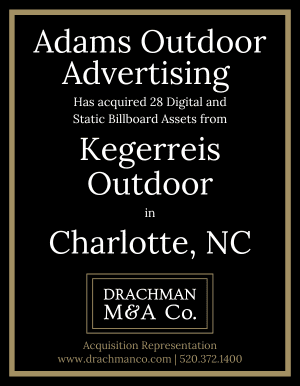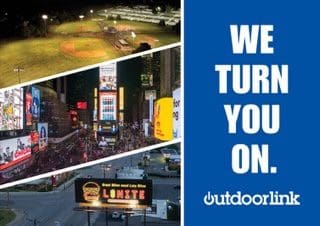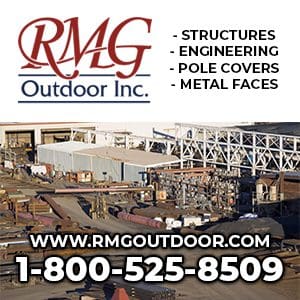
Insider dodged blizzards to visit South Dakota to tour Daktronics manufacturing facilities and meet marketing, sales and manufacturing executives. During the visit Insider interviewed Jeremy Johnson, Daktronics Global Out Of Home Solutions Manager about the digital billboard business. Here’s what Insider learned.
Company: Daktronics
Products: Advertising displays, including digital billboards, video displays, scoreboards and timing systems, ITS (intelligent transportation systems), message displays, audio systems, digit and price displays.
Headquarters: 201 Daktronics Dr., Brookings, SD 57006-5128. 800-325-8766.
2015 Revenue: $615 million. The Commercial division which sells digital billboards, accounted for $165 million of company revenues.
Status: Public (symbol: DAKT) since 1994.
Market capitalization: $327 million.
Employees: 2,800.
Manufacturing: Daktronics occupies 6 buildings along Daktronics Drive at their corporate facility in Brookings, South Dakota. In 2006 the company opened manufacturing facilities Sioux Falls, South Dakota and Redwood Falls, Minnesota to accommodate growing business needs. To date the company has more than 600,000 square feet of manufacturing space, with nearly 80,000 sq ft allocated to digital billboard manufacturing in Sioux Falls, SD.
Market Share: Based on industry data, Daktronics is the leading provider of digital billboards with more than half of the total digital signs installed out of a base of approximately 6,000 digital signs in the United States.
Jeremy, talk about Daktronics history.
Daktronics was started in 1968 by a Dr Al Kurtenbach and Dr Duane Sander, two South Dakota State University electrical engineering professors who were looking for a way to create jobs for South Dakota State grads. You can hear one of our founders talking about our values here. The company’s earliest products were an electronic vote tabulating system and a portable wrestling scoreboard. Over time the company branched out to become the market leader in LED signs including scoreboards, message displays, highway displays, on-premise signs and digital billboards. In 2001 the company produced its first digital billboard.
What’s made Daktronics the digital billboard market leader?
We listened. It was important for us to understand the unique needs of this business. OOH operators have different needs than many of our other customers. We needed to tailor everything to them; software, display mechanics, display operations, service and all other after sale support. By bringing the right mix of technology, service and features to our customers, we were able to capture great market share early on as this business was ramping up. From that point on, it was all about refining and continuous innovation. Much of this focus was, and continues to be, on lowering overall cost of ownership. It was also critical that we played a role in improving the regulatory climate for the industry as it related to Digital BBs. As such, we invested a great deal of time and capital helping to fund safety studies and played a part in many significant regulatory battles throughout the country. This is a commitment that continues today.
Research and development is a company emphasis. How has this paid off?
2010 Dak bldg 6 eidted-2Daktronics spends 4% of our annual revenue each year on R&D. In Fiscal Year 2015, this equated to more than $24 million dollars. We use this capital to do many things, but our primary focus is two-fold; new product development and improving on current designs. Both efforts require a great deal of testing. In an effort to improve the results and efficiency of our testing process, we have invested heavily over the past few years in our Reliability Testing Laboratories. In our labs we expose our components and designs to a battery of tests configured to represent the worst that Mother Nature can produce, and then some. Additionally, we do expansive emissions testing to ensure that our displays meet the strict guidelines of the FCC and do not cause you any harm from interference in the field.
What is Daktronics doing to meet the needs of independent billboard companies?
DaktronicsOOHteamIndependent operators make up a very significant part of our install base and represent the fastest growing segment of our OOH business. Our success with this group stems again from how we have listened and respond to the needs of this customer segment. In order to serve this group, we have created ‘teams’ of sales and after sales staff that are organized regionally throughout the US. These groups focus solely on Independent Operators. This ensures that they get the world class support both before and after the sale that is expected from Daktronics.
In our most recent product release, the DB-5000, we have introduced many new features in our display design and software that are geared towards Independent Operators. These features allow them to save money during installation and make more money by having more power and flexibility in their display control software.
What has been the history of digital billboard prices and where are prices headed?
From 2000-2009 digital billboard prices dropped by double digits each year. Since then, the product cost reductions have slowed and attention has been turned to lowering Operational Costs. Great strides have been made in this regard. What we have right now is a very mature product. Electronic components make up over 80% of a displays overall cost. These electronic components, including the LEDs, are simply not coming down in price as they once were. Buyers have many options to spend less on displays from companies importing their products from overseas, but it is important to understand that lower prices come with tradeoffs. When outdoor LED products were first coming into the market, there were many opportunities to lower cost through innovation. Advances in electronic architectural designs allowed for greater efficiency and use of new, more efficient parts. In a mature product, the primary way to lower cost is to sacrifice something; lifetime, performance, image, etc. Unfortunately, buyers are not able to see the sacrifices that were made until it is too late, costing them more money than anticipated.
What’s on the horizon and will the technology change?
Right now LED is the most stable, proven and efficient technology for outdoor applications. This is the only technology that can effectively compete with the sun and hold up in harsh environments. I believe that we will see changes in how advertising on displays is sold and purchased. Advertising exchanges and new buying platforms seem to have a great deal to offer and will add value to OOH. Additionally, technology is allowing us to know more about the mobile consumer; where they are, what kind of buyer they are and where they like to spend their money. Incorporating all this will provide a great boost to the OOH business. It’s exciting to think about where we will be in the next five to ten years.














